Evaluating the Performance of Pulsed and Continuous-Wave Lidar Wind Profilers with a Controlled Motion Experiment
Abstract
:1. Introduction
2. The Grimstad Experiment—Site Specifications
3. Lidar Theory
Motion Effect on Lidar Measurements
4. Methods
4.1. Motion Correction
4.2. Data Filtering and Statistical Methods
5. Results
5.1. Lidars’ Performance with No Motion: Baseline Test Cases
5.2. Lidars’ Performance in Presence of the Motion
5.2.1. Rotational Motion: Yaw (Rotation along Z Axis)
5.2.2. Rotational Motion: Pitch (Rotation along N–S)
5.2.3. Rotational Motion: Roll (Rotation along E–W)
5.2.4. Vertical Motion along Z Axis (Heave)
5.2.5. Horizontal Motion along N–S Axis (Surge)
5.3. Discussion of the Observed Motion-Induced Errors
5.4. Applying Motion Correction
6. Summary and Conclusions
- Yaw motion with a frequency close to the sampling frequency of the lidar can cause underestimation of mean wind speed for moving lidars. In our observations, the APE for the WindCube V1 exceeded 14%, while for the ZephIR 300 the APE remained below 6%.The correlation between the moving and reference lidars varied between 0.25 and 0.75, while the ZephIR 300 lidars showed a higher correlation than WindCube V1 at all yaw test cases.
- Pitch motion (rotation along the N–S direction) with moderate frequency did not cause a significant discrepancy. Yet, as the motion amplitude increased, APE between the moving and reference lidar for both types increased following with a drop in correlation between lidars. This was the case for TI estimates as well. Our results showed that the motion-induced errors are affected more by pitch motion amplitude than by motion frequency.
- Roll motion (rotation along the E–W direction) showed a marginally lower average wind speed for moving lidars compared to the reference lidars at both 85 m and 145 m. Additionally, their TI estimations were higher than reference lidars at both heights. Higher TI was observed in higher frequency test cases. The APE between moving and reference lidars was observed to be less than 5%. The high correlation between lidars persisted even with motion, but a decline in correlation was observed at the greater height (145 m).
- Heave motion (vertical motion along the Z-axis) caused the moving lidars to measure mean wind speeds equal to or slightly lower than reference lidars. The WindCube V1 lidars had a higher discrepancy in TI estimations than ZephIR 300. The APE between the moving and reference lidars was less than 5% for both types at 85 m while this value increased for WindCube at 145 m.
- Surge motion (horizontal movement in N–S direction) results showed the moving and reference lidars had similar mean wind speeds and APE less than 2.5% in 85 m and less than 7.5% at 145 m. In these test cases, strong correlation between lidars was observed. TI estimates of moving lidars were higher than those of the reference lidars. Our results showed that while surge motion had negligible effect on the ZephIR 300, the WindCube V1 had susceptibility to motion-induced errors.
Author Contributions
Funding
Data Availability Statement
Acknowledgments
Conflicts of Interest
Abbreviations
| APE | Absolute Percentage Error |
| CNR | Carrier-to-Noise Ratio |
| CW | Continuous Wave |
| DBS | Doppler Beam Swinging |
| DOF | Degree of Freedom |
| FLS | Floating Lidar System |
| LOS | Line of Sight |
| MAD | Mean Absolute Deviation |
| NaN | Not a Number |
| TI | Turbulence Intensity |
| UTC | Universal Time Coordinated |
| VAD | Velocity Azimuth Display |
Appendix A. Test Specifications
| Test No. | Start Time | Motion | Amplitude () | Frequency () | Comments |
|---|---|---|---|---|---|
| 01 | 2011-08-16 15:50 | initial test | variable motions | ||
| 02 | 2011-08-16 17:43 | baseline | no movement | - | - |
| 03 | 2011-08-17 06:33 | heave | 40 cm | 0.1 Hz | - |
| 04 | 2011-08-17 10:04 | heave | 40 cm | 0.2 Hz | - |
| 05 | 2011-08-17 13:33 | heave | 40 cm | 0.15 Hz | - |
| 06 | 2011-08-17 16:52 | surge (N–S) | 40 cm | 0.1 Hz | - |
| 07 | 2011-08-17 20:22 | baseline | no movement | - | WLS7-65 not measuring; condensation on the lens |
| 08 | 2011-08-18 06:28 | tilt (N–S) | 3° | 0.2 Hz | - |
| 09 | 2011-08-18 08:52 | tilt (N–S) | 5° | 0.2 Hz | - |
| 10 | 2011-08-18 11:32 | tilt (N–S) | 10° | 0.2 Hz | - |
| 11 | 2011-08-18 14:34 | tilt (N–S) | 15° | 0.2 Hz | - |
| 12 | 2011-08-18 18:01 | tilt (E–W) | 15° | 0.2 Hz | - |
| 13 | 2011-08-18 20:21 | baseline | no movement | - | - |
| 14 | 2011-08-19 06:26 | circle (N–S) | 30 cm | 0.2 Hz | - |
| 15 | 2011-08-19 09:32 | circle & tilt (N–S) | 30 cm & 5° | 0.2 Hz | - |
| 16 | 2011-08-19 12:42 | circle & tilt (N–S) | 30 cm & 10° | 0.2 Hz | - |
| 17 | 2011-08-19 16:22 | circle & tilt (N–S) | 30 cm & 3° | 0.2 Hz | - |
| 18 | 2011-08-19 19:52 | baseline | no movement | - | WLS7-65 not measuring; condensation on the lens |
| 19 | 2011-08-20 06:13 | yaw | 39° | 0.1 Hz | - |
| 20 | 2011-08-20 09:32 | yaw | 39° | 0.2 Hz | - |
| 21 | 2011-08-20 12:42 | yaw | 39° | 0.05 Hz | - |
| 22 | 2011-08-20 15:02 | tilt (E–W) | 10° | 0.2 Hz | - |
| 23 | 2011-08-20 17:44 | tilt (E–W) | 5° | 0.2 Hz | - |
| 24 | 2011-08-20 20:32 | baseline | no movement | - | - |
| 25 | 2011-08-21 05:21 | tilt (E–W) | 3° | 0.2 Hz | - |
| 26 | 2011-08-21 10:05 | tilt (E–W) | 3° | 0.1 Hz | - |
| 27 | 2011-08-21 12:55 | tilt (E–W) | 5° | 0.1 Hz | - |
| 28 | 2011-08-21 15:31 | tilt (E–W) | 10° | 0.1 Hz | - |
| 29 | 2011-08-21 17:33 | tilt (E–W) | 15° | 0.1 Hz | - |
| 30 | 2011-08-21 21:01 | baseline | no movement | - | WLS7-65 not measuring; condensation on the lens |
| 31 | 2011-08-22 06:42 | surge (N–S) | 40cm | 0.1 Hz | - |
| 32 | 2011-08-22 09:04 | circle & tilt (N–S) | 30 cm & 12.5° | 0.1 Hz | - |
| 33 | 2011-08-22 12:01 | circle & tilt (N–S) | 30 cm & 12.5° | 0.2 Hz | - |
| 34 | 2011-08-22 14:32 | circle & tilt (N–S) | 30 cm & 5° | 0.1 Hz | - |
| 35 | 2011-08-22 16:51 | circle & tilt (N–S) | 30 cm & 3° | 0.2 Hz | - |
| 36 | 2011-08-22 18:51 | heave | 40 cm | 0.1 Hz | - |
| 37 | 2011-08-22 19:41 | baseline | no movement | - | - |
| 38 | 2011-08-23 06:22 | heave & tilt (N–S) | 40 cm & 5° | 0.1 Hz | - |
| 39 | 2011-08-23 10:35 | circle & tilt (N–S) | 30 cm & 3° + 3° offset | 0.2 Hz | - |
| 40 | 2011-08-23 13:01 | circle & tilt (N–S) | 30 cm & 5° + 5° offset | 0.2 Hz | - |
| 41 | 2011-08-23 15:34 | file: Fresh breeze | max. 14° | - | - |
| 42 | 2011-08-23 18:01 | file: Storm | max. 21° | - | - |
| 43 | 2011-08-23 20:32 | baseline | no movement | - | - |
| 44 | 2011-08-24 06:02 | file: Hurricane | Max 21° | - | - |
| 45 | 2011-08-24 09:02 | file: Moderate breeze | Max 14° | - | - |
| 46 | 2011-08-24 12:02 | file: Moderate gale | Max 17° | - | - |
| 47 | 2011-08-24 15:22 | file: Strong gale | Max 20° | - | - |
| 48 | 2011-08-24 17:11 | yaw | 39° | 0.15 Hz | - |
| 49 | 2011-08-24 18:44 | yaw | 39° | 0.025 Hz | - |
| 50 | 2011-08-24 20:12 | baseline | No movement | - | - |
| 51 | 2011-08-25 06:05 | tilt (E–W) | 15° | 0.1 Hz | - |
| 52 | 2011-08-25 08:31 | tilt (N–S) | 20° | 0.1 Hz | - |
| 53 | 2011-08-25 10:51 | circle & tilt (N–S) | 30 cm & 5°+5° offset | 0.2 Hz | - |
| 54 | 2011-08-25 12:31 | surge | 40 cm | 0.2 Hz | - |
| 55 | 2011-08-25 14:41 | tilt N–S | 10° | 0.1 Hz | - |
| 56 | 2011-08-25 16:12 | heave | 20 cm | 0.4 Hz | - |
| 57 | 2011-08-25 17:50 | stop | - | - | - |
Appendix B. Height Settings
| Moving Lidars | Reference Lidars | |||
|---|---|---|---|---|
| Level No. | WindCube V1 (m) | ZephIR 300 (m) | WindCube V1 (m) | ZephIR 300 (m) |
| 10 | 197 | 197 | 200 | 200 |
| 9 | 157 | 157 | 160 | 160 |
| 8 | 142 | 142 | 145 | 145 |
| 7 | 127 | 127 | 130 | 130 |
| 6 | 112 | 112 | 115 | 115 |
| 5 | 97 | 97 | 100 | 100 |
| 4 | 82 | 82 | 85 | 85 |
| 3 | 67 | 67 | 70 | 70 |
| 2 | 52 | 52 | 55 | 55 |
| 1 | 40 | 40 | 43 | 43 |
| Moving Lidars | Reference Lidars | |||
|---|---|---|---|---|
| Level No. | WindCube V1 (m) | ZephIR 300 (m) | WindCube V1 (m) | ZephIR 300 (m) |
| 10 | 197 | 142 | 200 | 145 |
| 9 | 157 | 82 | 160 | 85 |
| 8 | 142 | 82 | 145 | 85 |
| 7 | 127 | 82 | 130 | 85 |
| 6 | 112 | 82 | 115 | 85 |
| 5 | 97 | 82 | 100 | 85 |
| 4 | 82 | 82 | 85 | 85 |
| 3 | 67 | 82 | 70 | 85 |
| 2 | 52 | 82 | 55 | 85 |
| 1 | 40 | 40 | 43 | 43 |
References
- Veers, P.; Dykes, K.; Basu, S.; Bianchini, A.; Clifton, A.; Green, P.; Holttinen, H.; Kitzing, L.; Kosovic, B.; Lundquist, J.K.; et al. Grand Challenges: Wind energy research needs for a global energy transition. Wind. Energy Sci. Discuss. 2022, 2022, 1–8. [Google Scholar] [CrossRef]
- Fischer, G. Installation and Operation of the Research Platform FINO 1 in the North Sea. In Offshore Wind Energy; Köller, J., Köpper, J., Peters, W., Eds.; Springer: Berlin/Heidelberg, Germany, 2006; pp. 237–253. [Google Scholar] [CrossRef]
- Poveda Maureira, J.P.; Wouters, D.A.J. Wind Measurements at Meteorological Mast IJmuiden; Technical Report February; Report ECN-E–14-058; Energy Center of the Netherlands (ECN): Petten, The Netherlands, 2015. [Google Scholar]
- Hasager, C.B.; Peña, A.; Christiansen, M.B.; Astrup, P.; Nielsen, M.; Monaldo, F.; Thompson, D.; Nielsen, P. Remote sensing observation used in offshore wind energy. IEEE J. Sel. Top. Appl. Earth Obs. Remote Sens. 2008, 1, 67–79. [Google Scholar] [CrossRef]
- Liu, Z.; Barlow, J.F.; Chan, P.W.; Fung, J.C.H.; Li, Y.; Ren, C.; Mak, H.W.L.; Ng, E. A Review of Progress and Applications of Pulsed Doppler Wind LiDARs. Remote Sens. 2019, 11, 2522. [Google Scholar] [CrossRef]
- Reuder, J.; Cheynet, E.; Clifton, A.; van Dooren, M.F.; Gottschall, J.; Jakobsen, J.B.; Mann, J.; Palma, J.; Schlipf, D.; Sjøholm, M.; et al. Recommendation on Use of Wind Lidars; Technical report; Geophysical Institute and Bergen Offshore Wind Centre (BOW), University of Bergen: Bergen, Norway, 2021. [Google Scholar] [CrossRef]
- Gottschall, J.; Wolken-Möhlmann, G.; Lange, B. About offshore resource assessment with floating lidars with special respect to turbulence and extreme events. J. Phys. Conf. Ser. 2014, 555, 012043. [Google Scholar] [CrossRef]
- Wagner, R.; Pedersen, T.F.; Courtney, M.; Antoniou, I.; Davoust, S.; Rivera, R. Power curve measurement with a nacelle mounted lidar. Wind Energy 2014, 17, 1441–1453. [Google Scholar] [CrossRef]
- Bossanyi, E.; Kumar, A.; Hugues-Salas, O. Wind turbine control applications of turbine-mounted LIDAR. J. Phys. Conf. Ser. 2014, 555, 012011. [Google Scholar] [CrossRef]
- Gräfe, M.; Pettas, V.; Gottschall, J.; Cheng, P.W. Quantification and correction of motion influence for nacelle-based lidar systems on floating wind turbines. Wind Energy Sci. 2023, 8, 925–946. [Google Scholar] [CrossRef]
- Cañadillas, B.; Westerhellweg, A.; Neumann, T. Testing the Performance of a Ground-based Wind LiDAR System One Year Intercomparison at the Offshore. DEWI Mag. 2011, 38, 58–65. [Google Scholar]
- Hasager, C.B.; Stein, D.; Courtney, M.; Peña, A.; Mikkelsen, T.; Stickland, M.; Oldroyd, A. Hub height ocean winds over the north sea observed by the NORSEWInD lidar array: Measuring techniques, quality control and data management. Remote Sens. 2013, 5, 4280–4303. [Google Scholar] [CrossRef]
- Peña, A.; Gryning, S.E.; Floors, R. Lidar observations of marine boundary-layer winds and heights: A preliminary study. Meteorol. Z. 2015, 24, 581–589. [Google Scholar] [CrossRef]
- Gottschall, J.; Wolken-Möhlmann, G.; Viergutz, T.; Lange, B. Results and conclusions of a floating-lidar offshore test. Energy Procedia 2014, 53, 156–161. [Google Scholar] [CrossRef]
- Achtert, P.; Brooks, I.M.; Brooks, B.J.; Moat, B.I.; Prytherch, J.; Persson, P.O.G.; Tjernström, M. Measurement of wind profiles by motion-stabilised ship-borne Doppler lidar. Atmos. Meas. Tech. 2015, 8, 4993–5007. [Google Scholar] [CrossRef]
- Gottschall, J.; Catalano, E.; Dörenkämper, M.; Witha, B. The NEWA Ferry Lidar Experiment: Measuring Mesoscale Winds in the Southern Baltic Sea. Remote Sens. 2018, 10, 1620. [Google Scholar] [CrossRef]
- Duscha, C.; Paskyabi, M.B.; Reuder, J. Statistic and coherence response of ship-based lidar observations to motion compensation. J. Phys. Conf. Ser. 2020, 1669, 012020. [Google Scholar] [CrossRef]
- Kelberlau, F.; Neshaug, V.; Lønseth, L.; Bracchi, T.; Mann, J. Taking the Motion out of Floating Lidar: Turbulence Intensity Estimates with a Continuous-Wave Wind Lidar. Remote Sens. 2020, 12, 898. [Google Scholar] [CrossRef]
- Pichugina, Y.L.; Banta, R.M.; Brewer, W.A.; Sandberg, S.P.; Hardesty, R.M. Doppler Lidar–Based Wind-Profile Measurement System for Offshore Wind-Energy and Other Marine Boundary Layer Applications. J. Appl. Meteorol. Climatol. 2012, 51, 327–349. [Google Scholar] [CrossRef]
- Wolken-Möhlmann, G.; Gottschall, J.; Lange, B. First Verification Test and Wake Measurement Results Using a SHIP-LIDAR System. Energy Procedia 2014, 53, 146–155. [Google Scholar] [CrossRef]
- Duscha, C.; Barrell, C.; Renfrew, I.A.; Brooks, I.M.; Sodemann, H.; Reuder, J. A Ship-Based Characterization of Coherent Boundary-Layer Structures Over the Lifecycle of a Marine Cold-Air Outbreak. Bound.-Layer Meteorol. 2022, 183, 355–380. [Google Scholar] [CrossRef]
- Rubio, H.; Kühn, M.; Gottschall, J. Evaluation of low-level jets in the southern Baltic Sea: A comparison between ship-based lidar observational data and numerical models. Wind Energy Sci. 2022, 7, 2433–2455. [Google Scholar] [CrossRef]
- Hill, R.J.; Brewer, W.A.; Tucker, S.C. Platform-motion correction of velocity measured by Doppler lidar. J. Atmos. Ocean. Technol. 2008, 25, 1369–1382. [Google Scholar] [CrossRef]
- Gottschall, J.; Gribben, B.; Stein, D.; Würth, I. Floating lidar as an advanced offshore wind speed measurement technique: Current technology status and gap analysis in regard to full maturity. Wiley Interdiscip. Rev. Energy Environ. 2017, 6, e250. [Google Scholar] [CrossRef]
- Désert, T.; Knapp, G.; Aubrun, S. Quantification and Correction of Wave-Induced Turbulence Intensity Bias for a Floating LIDAR System. Remote Sens. 2021, 13, 2973. [Google Scholar] [CrossRef]
- Gutiérrez-Antuñano, M.; Tiana-Alsina, J.; Salcedo, A.; Rocadenbosch, F. Estimation of the Motion-Induced Horizontal-Wind-Speed Standard Deviation in an Offshore Doppler Lidar. Remote Sens. 2018, 10, 2037. [Google Scholar] [CrossRef]
- Kelberlau, F.; Mann, J. Quantification of motion-induced measurement error on floating lidar systems. Atmos. Meas. Tech. 2022, 15, 5323–5341. [Google Scholar] [CrossRef]
- Tucker, S.C.; Senff, C.J.; Weickmann, A.M.; Brewer, W.A.; Banta, R.M.; Sandberg, S.P.; Law, D.C.; Hardesty, R.M. Doppler Lidar Estimation of Mixing Height Using Turbulence, Shear, and Aerosol Profiles. J. Atmos. Ocean. Technol. 2009, 26, 673–688. [Google Scholar] [CrossRef]
- Zentek, R.; Kohnemann, S.H.E.; Heinemann, G. Analysis of the performance of a ship-borne scanning wind lidar in the Arctic and Antarctic. Atmos. Meas. Tech. 2018, 11, 5781–5795. [Google Scholar] [CrossRef]
- Bischoff, O.; Schlipf, D.; Würth, I.; Cheng, P. Dynamic Motion Effects and Compensation Methods of a Floating Lidar Buoy. In Proceedings of the EERA DeepWind 2015 Deep Sea Offshore Wind Conference, Trondheim, Norway, 4–6 February 2015; pp. 4–6. [Google Scholar]
- Thebault, N.; Thiébaut, M.; Le Boulluec, M.; Damblans, G.; Maisondieu, C.; Benzo, C.; Guinot, F. Experimental evaluation of the motion-induced effects on turbulent fluctuations measurement on floating lidar systems. Wind Energy Sci. Discuss. 2023, 2023, 1–22. [Google Scholar]
- Banakh, V.A.; Smalikho, I.N.; Köpp, F.; Werner, C. Representativeness of wind measurements with a CW Doppler lidar in the atmospheric boundary layer. Appl. Opt. 1995, 34, 2055–2067. [Google Scholar] [CrossRef] [PubMed]
- Peña, A.; Hasager, C.B.; Lange, J.; Anger, J.; Badger, M.; Bingöl, F.; Bischoff, O.; Cariou, J.P.; Dunne, F.; Emeis, S.; et al. Remote Sensing for Wind Energy; DTU Wind Energy: Roskilde, Denmark, 2013. [Google Scholar]
- Haakenstad, H.; Breivik, Ø.; Furevik, B.R.; Reistad, M.; Bohlinger, P.; Aarnes, O.J. NORA3: A nonhydrostatic high-resolution hindcast of the North Sea, the Norwegian Sea, and the Barents Sea. J. Appl. Meteorol. Climatol. 2021, 60, 1443–1464. [Google Scholar] [CrossRef]
- Pearson, G.; Davies, F.; Collier, C. An analysis of the performance of the UFAM pulsed Doppler lidar for observing the boundary layer. J. Atmos. Ocean. Technol. 2009, 26, 240–250. [Google Scholar] [CrossRef]
- Pham-Gia, T.; Hung, T.L. The mean and median absolute deviations. Math. Comput. Model. 2001, 34, 921–936. [Google Scholar] [CrossRef]
- Leys, C.; Ley, C.; Klein, O.; Bernard, P.; Licata, L. Detecting outliers: Do not use standard deviation around the mean, use absolute deviation around the median. J. Exp. Soc. Psychol. 2013, 49, 764–766. [Google Scholar] [CrossRef]
- Duscha, C. Characterizing the Convective Boundary Layer with Wind-Profiling and Scanning Doppler Lidar. Ph.D. Thesis, The University of Bergen, Bergen, Norway, 2024. [Google Scholar]
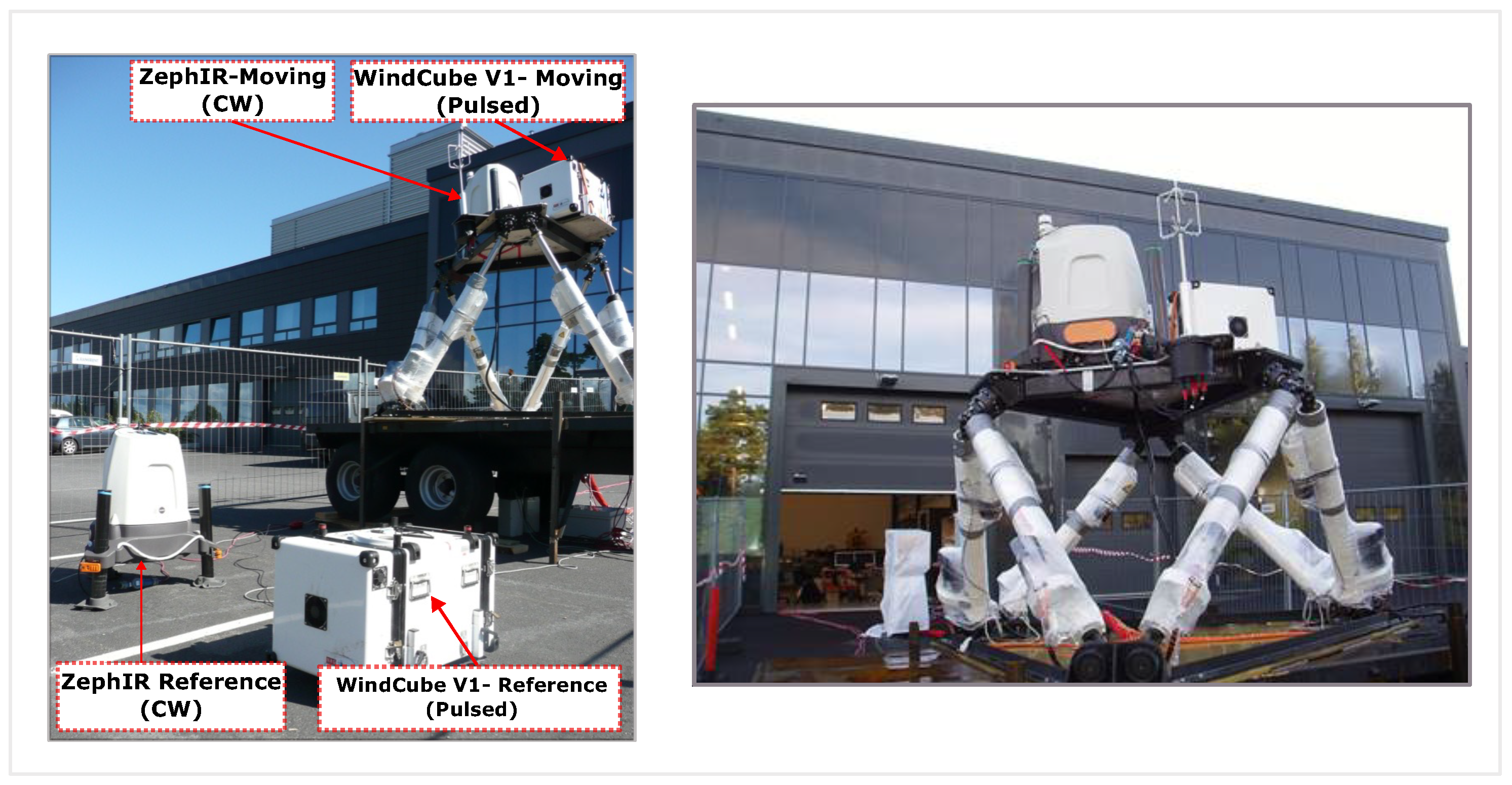
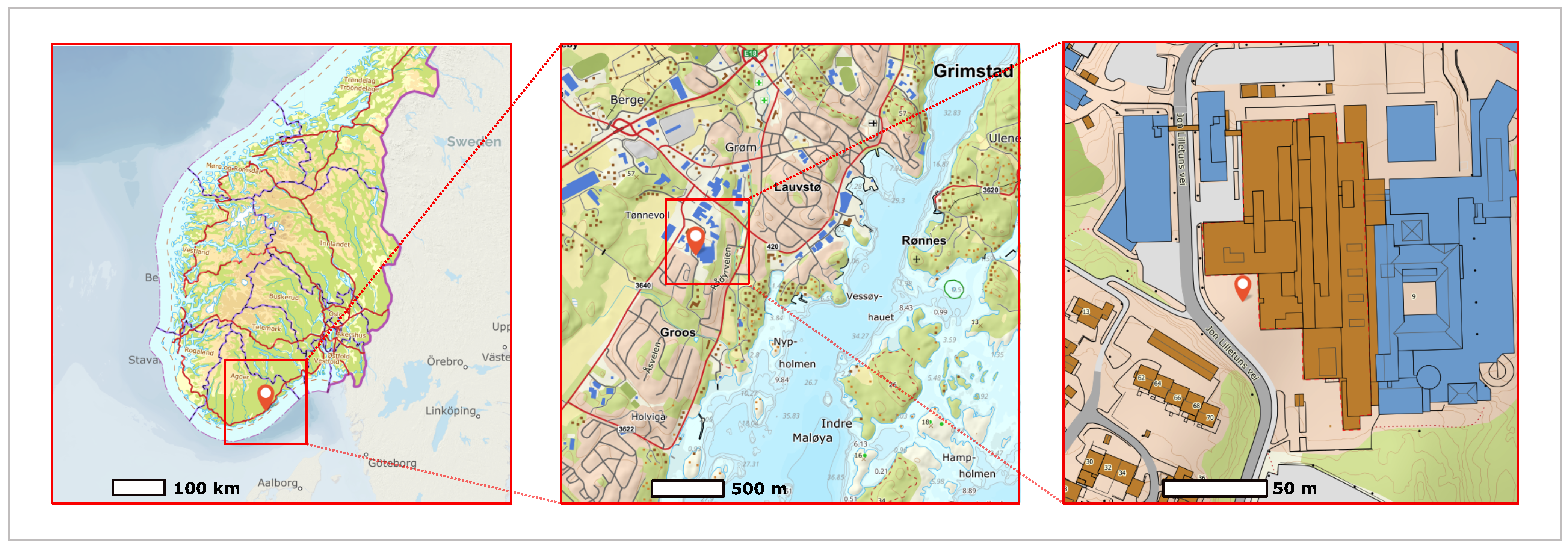


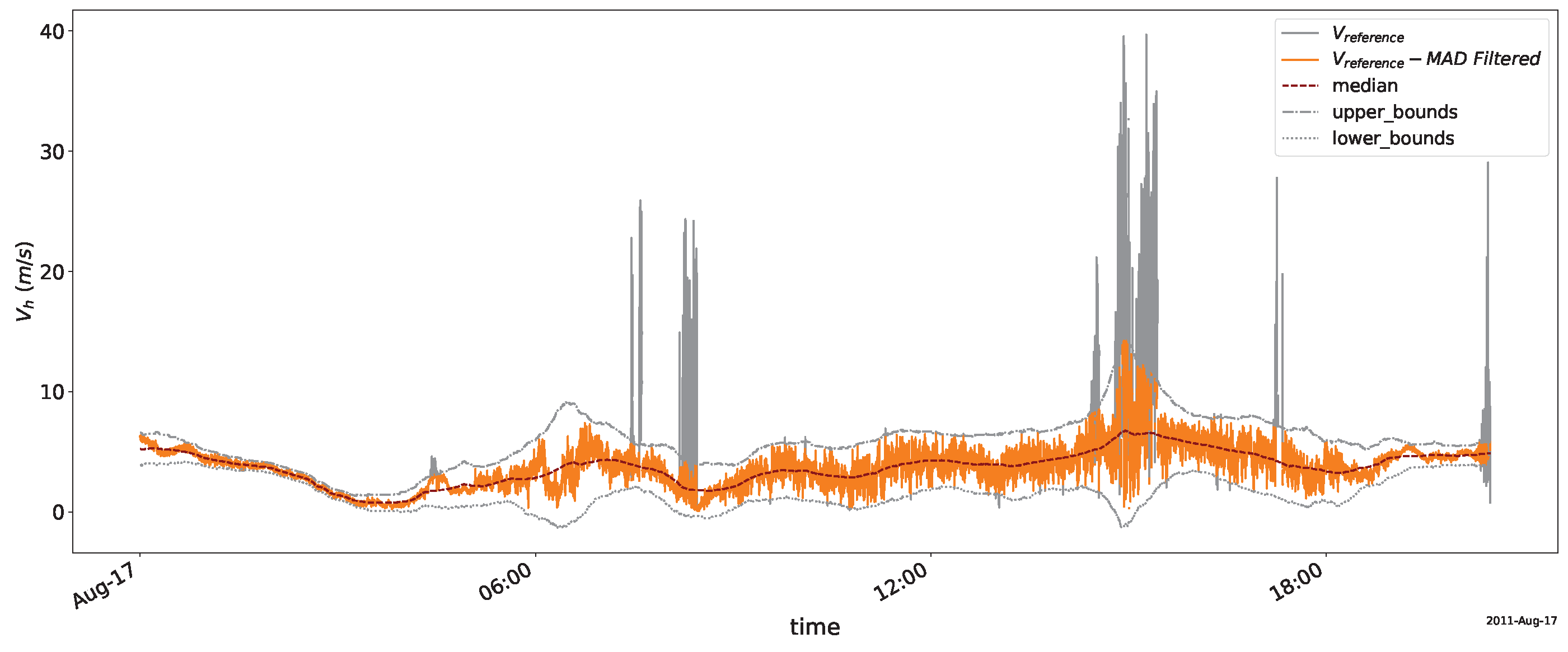
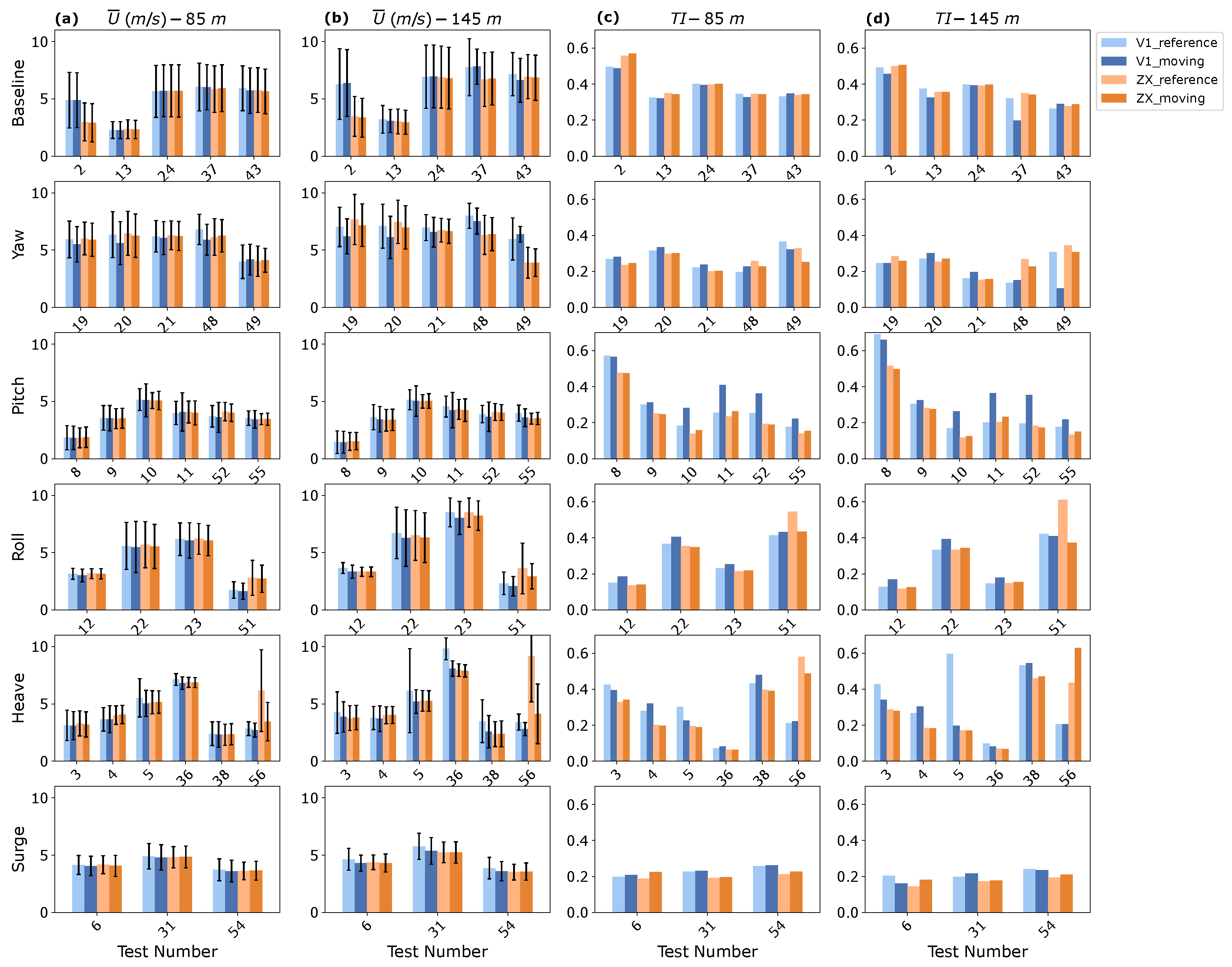
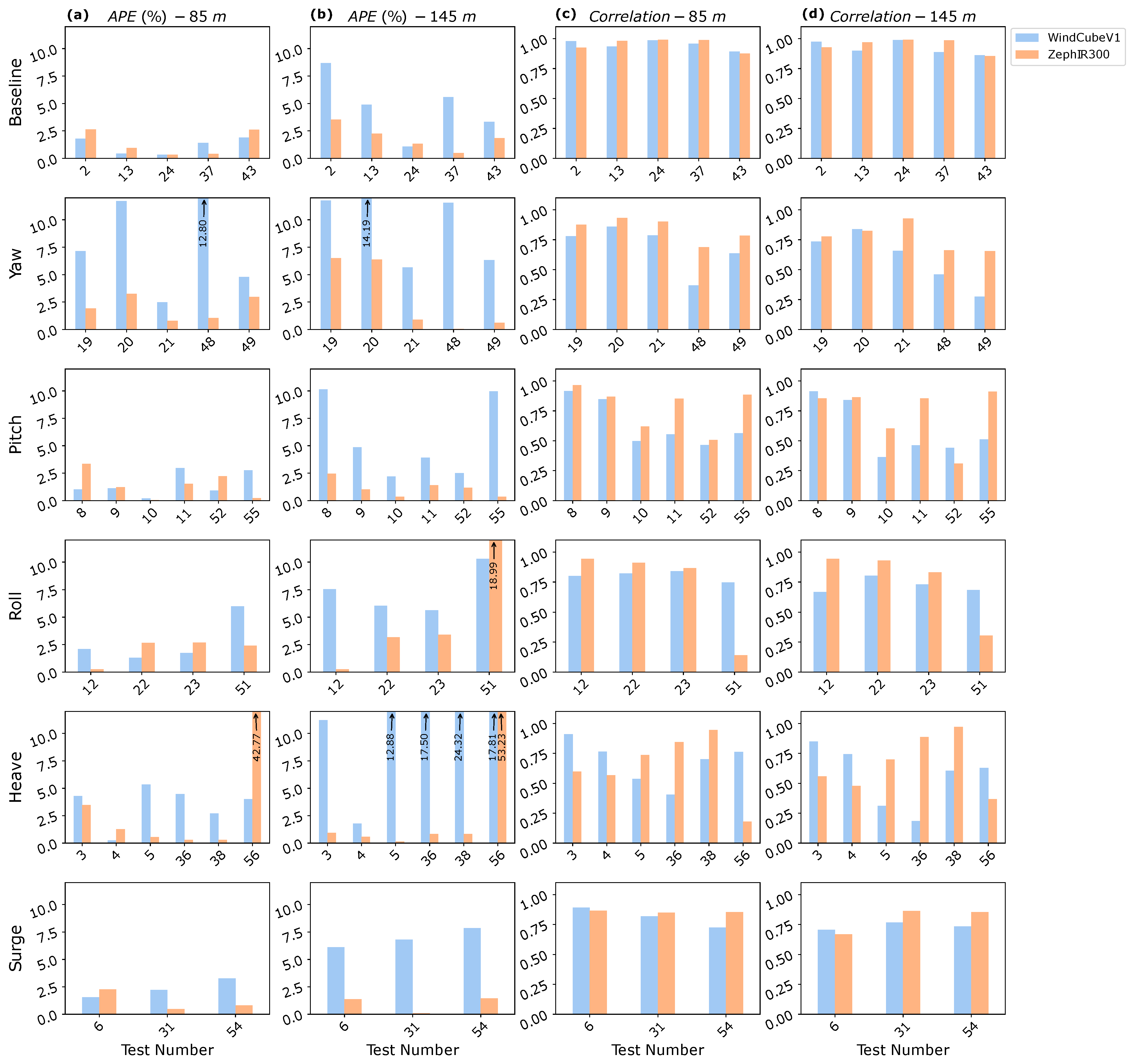

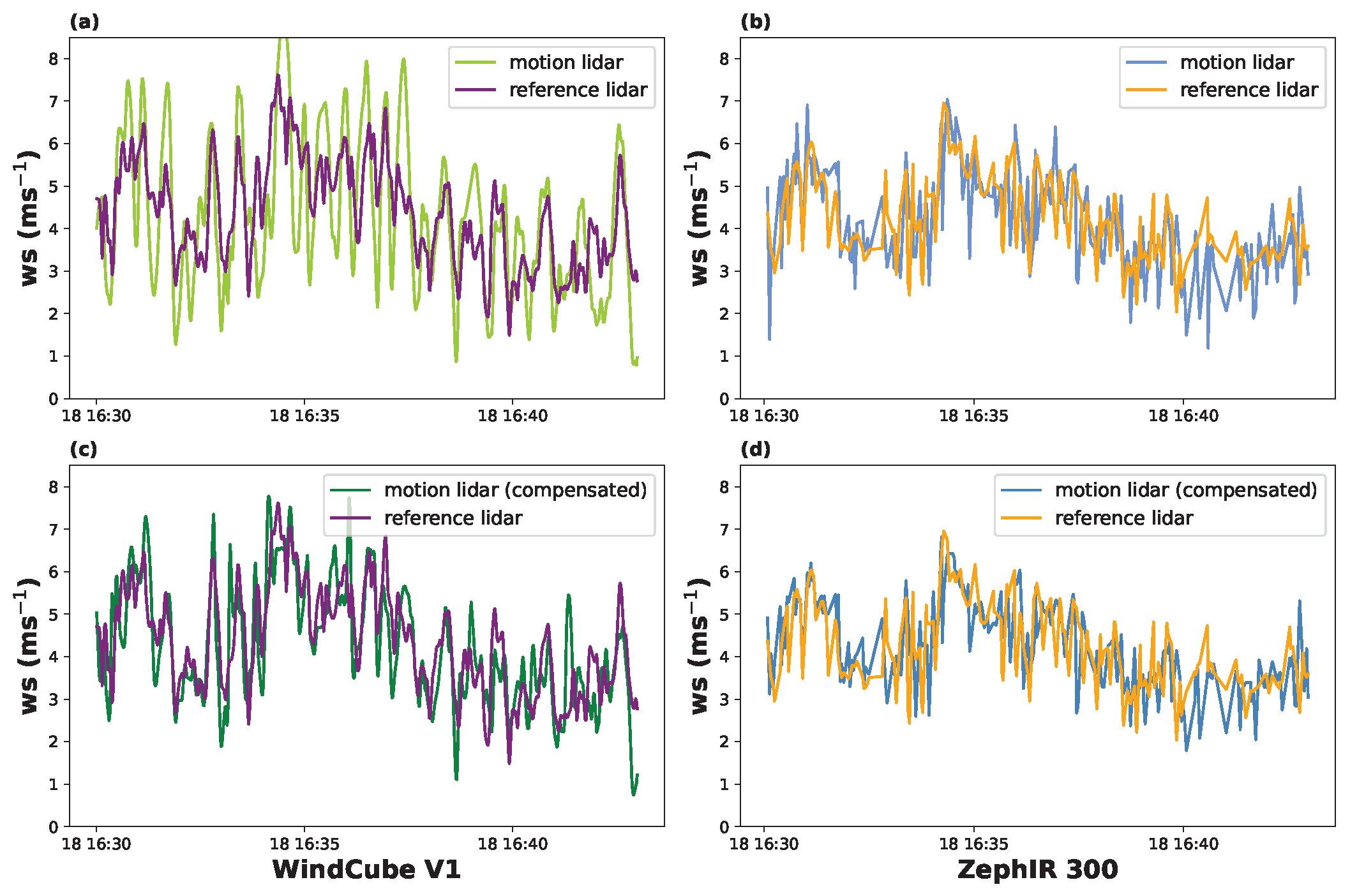
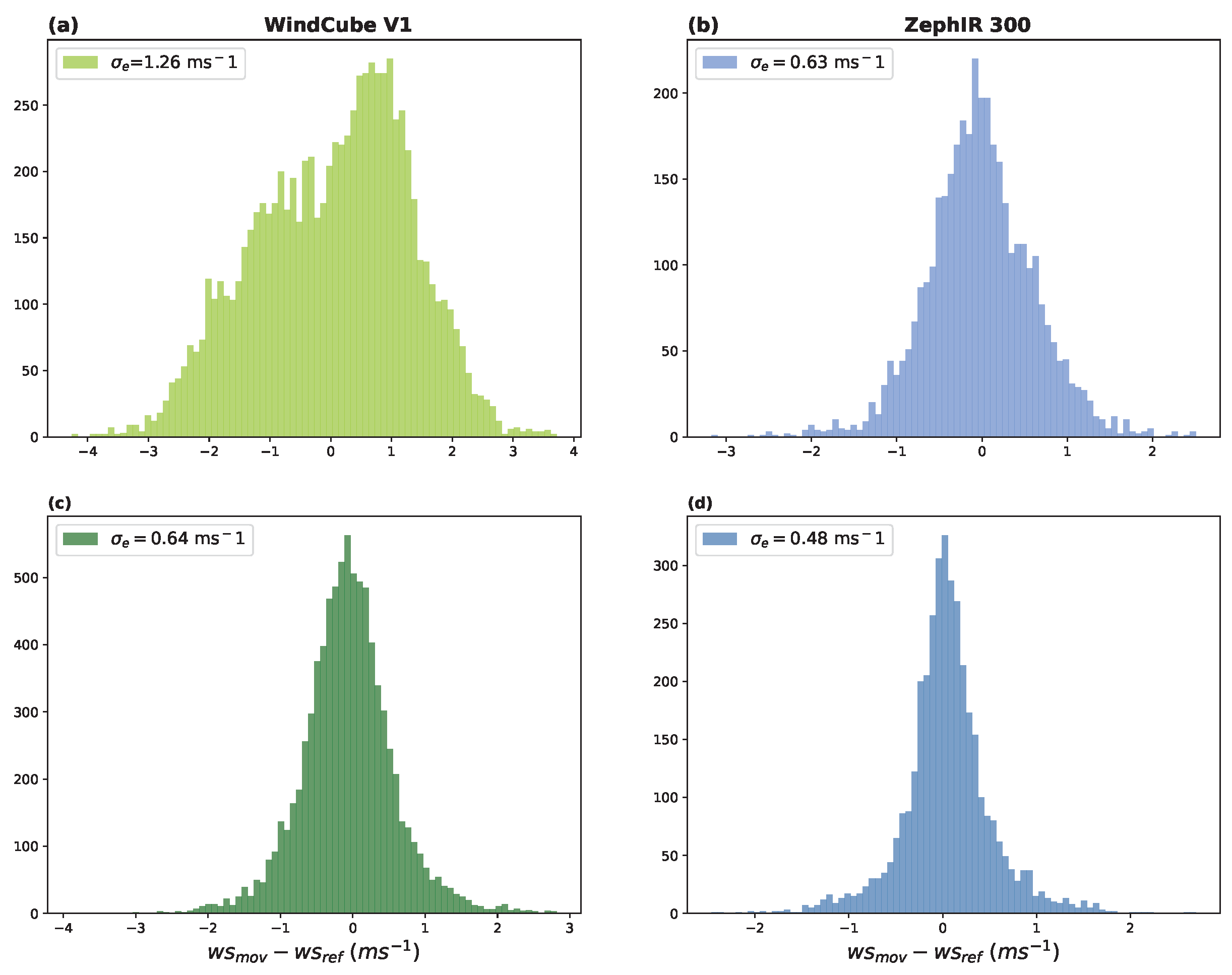

Disclaimer/Publisher’s Note: The statements, opinions and data contained in all publications are solely those of the individual author(s) and contributor(s) and not of MDPI and/or the editor(s). MDPI and/or the editor(s) disclaim responsibility for any injury to people or property resulting from any ideas, methods, instructions or products referred to in the content. |
© 2024 by the authors. Licensee MDPI, Basel, Switzerland. This article is an open access article distributed under the terms and conditions of the Creative Commons Attribution (CC BY) license (https://creativecommons.org/licenses/by/4.0/).
Share and Cite
Malekmohammadi, S.; Duscha, C.; Jenkins, A.D.; Kelberlau, F.; Gottschall, J.; Reuder, J. Evaluating the Performance of Pulsed and Continuous-Wave Lidar Wind Profilers with a Controlled Motion Experiment. Remote Sens. 2024, 16, 3191. https://doi.org/10.3390/rs16173191
Malekmohammadi S, Duscha C, Jenkins AD, Kelberlau F, Gottschall J, Reuder J. Evaluating the Performance of Pulsed and Continuous-Wave Lidar Wind Profilers with a Controlled Motion Experiment. Remote Sensing. 2024; 16(17):3191. https://doi.org/10.3390/rs16173191
Chicago/Turabian StyleMalekmohammadi, Shokoufeh, Christiane Duscha, Alastair D. Jenkins, Felix Kelberlau, Julia Gottschall, and Joachim Reuder. 2024. "Evaluating the Performance of Pulsed and Continuous-Wave Lidar Wind Profilers with a Controlled Motion Experiment" Remote Sensing 16, no. 17: 3191. https://doi.org/10.3390/rs16173191






